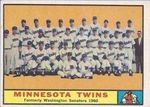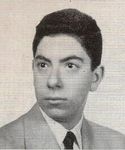The 1960 set: Len Brown's first big job at Topps
←
→
Page content transcription
If your browser does not render page correctly, please read the page content below
The 1960 set: Len Brown’s
first big job at Topps
By George Vrechek
In a previous SCD issue, Topps writer Len Brown recalled his 41 years of working on the various Topps
card products. The 1960 Topps baseball issue was one of the first projects assigned to Brown. This is the
story of Brown’s involvement in that set.
Len Brown 1957
$75 per week to start
Brown arrived at Topps in October 1959 as an 18-year-old, $75 per
week protégé of Topps product development director Woody
Gelman. Gelman gave Brown the job of writing the information to
put on the backs of the baseball cards. (I computed that if Brown
had taken his first year salary of roughly $3,900 in the form of
regular 1960 Topps baseball cards instead of cash and, for some
reason, stuck the sets in a drawer, they would be worth about $4.4 million today. Alternatively, he could
have used one week’s pay to buy 1960 Topps Mickey Mantle cards and put those in the drawer. The
7,500 Mantle cards would have taken up a lot less room than sets and would be worth $3.2 million
today. However, I digress and apologize to Brown for using the advantage of hindsight.)
Brown remembers Woody Gelman, Sy Berger, Len Harrison, Ben Solomon and others in management
sitting around debating whether to use an upright or horizontal orientation for the financially important
1960 baseball issue. Gelman and Solomon might mock up 35 ideas for card designs and whittle it down
to 5 or 6. Brown explained that they would “comp it up” preparing detailed mock-ups of each design
and then present those alternatives to a management committee.Topps featured several different front and back designs, making it a little more complicated to crank out a 1960 set.
Picking the players Topps had 572 cards in the 1959 issue which was the most they had ever included. They returned again in 1960 with 572 cards. With 16 major league teams of 25 players, there were only 400 regulars in the league. With the “card wars” pretty well over, the only big name not available to Topps was Ted Williams. (1960 was Ted’s last year and, according to Sy Berger, Topps wished him the best with his relatively well-paying deal to be exclusive on Fleer cards that year.) Therefore, there were many special cards to invent. Topps filled the sheets with all-stars, team cards, managers, coaches, rookies and cards featuring two or three players. Add in differences in how the backs were written and the gray or white back cardboard used and there are plenty of varieties in the 1960 set. Art director Ben Solomon would ask vice president of sales Sy Berger for the list of players to use for each series so they could get going with the photos and writing the backs. The photos of the players usually consisted of two full shots of the player, one head shot with hat and one head shot without a hat (in the event they were traded). Brown said, “Sy Berger, would go through the photography when the photos came in. I believe he might have instructed our photographers (one was George Hiatt...a very nice man), and Sy would assign a number of what he called combination cards in photos, a battery team for instance. I knew if there were combination cards in the series, I would have to write about a dozen lines of copy about the players on the front. The (1960 Topps # 57 ‘Win Savers’) Lown and Staley card was written from scratch and I used as many interesting facts as I could find about them in our reference material.” Willie Mays always seemed to be featured on at least one combination card on Berger’s lists. The 1960 list that Berger gave the art department included rookies Carl Yastrzemeski, Frank Howard and Jim Kaat. Most of the rookies were included in the first two series. Many stars were given back numbers ending with a zero or five. The big stars got the prominent card numbers: #50 Kaline, #200 Mays, #250 Musial, #300 Aaron, and #350 Mantle. Number 150 was Billy Pierce, who was not a huge star but a frequent dinner visitor to Sy Berger’s home when the White Sox visited New York. The 1961 team card (right) of the Minnesota Twins looked a lot like (in fact it was identical to) the 1960 team card of their predecessor Washington Senators (left). There would have been plenty of uniforms to airbrush, so Topps just added “formerly Washington Senators 1960” to their 1961 team card and left it at that.
Brown wrote the backs of the multiple-player cards from scratch. Willie Mays made it onto a number of
combination cards.
Jim Marshall was traded from the Cubs to the Red Sox.
Topps altered the logo on the small full shot on the left
and used a portrait with his hat turned up – except you
can still get a glimpse of the “C” for Cubs on his hat.
Topps used a hat-less portrait for Koufax. Did they
think he was going to get traded?Writing the backs Brown remembers that if a player had been in the big leagues for a while and had notable achievements over the past year, they used the bullet points of “Season’s Highlights” on the backs of the 1960 cards. The information could be gleaned from the reference sources and bullet points were easier to write than a small paragraph. Brown recalled, “I liked the Season’s Highlight feature, but unfortunately it was pretty old news by the time the following year’s cards were printed.” Brown thought that Stan Hart may have gathered the highlight information since he didn’t remember doing so. Hart was A.J. Shorin’s son- in-law. Brown remembers him as a very funny guy, who also wrote for Mad Magazine. Hart wanted to become a comedy writer, moved to California and later got an Emmy as the head writer for the Carol Burnett Show. He still consults with Topps. If there weren’t enough prior year highlights to use in bullet points, Brown would write a few sentences. A majority of the players had enough highlights to utilize the bullet points, but there were still plenty that needed small paragraphs that had to be written from scratch. In addition to the regular player cards there were the numerous special cards that either needed write-ups or at least cartoons. Brown commented that Topps wanted to be timely as to the player’s current team and would retouch photos, change information and add footnotes to reflect any trades before printing. In 1960 Topps went with a horizontal front for the last time on their vintage baseball cards. The horizontal 1960 backs had just the condensed stats and a cartoon. Brown said, “Personally, I liked the condensed stats because you had about the same room to write about each player. When they used the full year-by-year stats, I would always have to count how many lines of text would be left after showing all the years. Unfortunately, an experienced player would have little room left on the back of their card to include any text, whereas a rookie would have more room than you might need.” The art department would wind up going back to Brown to reduce the text, if there proved to be insufficient room on the back of the card. The writers got pretty good at writing one-line sentences for veterans. Whitebacks and graybacks I asked Brown about the white back and grayback variations in the 1960 set. He said that their principal printer was Lord Baltimore. However Topps also used a second printer, Zabel Brothers of Philadelphia. The first series was printed and ready to go early in the season and was usually their best seller. Topps wanted to make sure their next few series were delivered on schedule, and they felt two printers would be timelier than just one. They didn’t want to get stuck again with those crummy, unsold high numbers – like the 1952 Topps high numbers from Sy Berger’s debut year.
The Topps product development people (primarily Gelman) liked to have their printers use the good- looking, white-backed cardboard, but one printer couldn’t use the white board in their presses. Brown remembers art director Ben Solomon as being really dedicated to Topps and trying to save the company money whenever possible. The gray-backed cards were slightly cheaper to produce than the white- backed cards. Solomon would go with the gray backs, if he had a choice. A 1960 Topps master set – the first printing on the left was on whiteback cardboard, the next printing was all gray, and then both white and gray were used. Consequently there are print runs in the 1960 issue (as well as 1959) with either gray or white backs depending on which printer produced the cards. If you look at a master set of 1960 cards stacked in a box, you will have an idea of what went on. The first card numbers up to 110 are on white stock (the first printer). Cards 111 to 198 are on gray stock (the second printer). The next batch is on white stock followed by another batch on gray. Card numbers 375 to 440 are on both gray and white stock since both printers were needed to keep up with the shipments. Finally 441 to 572 are back on cheaper gray stock. What’s next? There wasn’t much down time after getting out the 1960 baseball cards. Football cards had to be written next, and again Brown was the 18-year-old man for the job. There were a few non-sports sets and then back to baseball again to get ready for the 1961 issue. My thanks to Len Brown for sharing his recollections of the card design process which resulted in so many products that we delve into today. I assured him that the details were of interest to collectors, and I look forward to checking in with him in the future to answer questions like: What were you guys thinking? George Vrechek is a freelance contributor to Sports Collectors Digest and can be contacted at vrechek@ameritech.net This article originally appeared in Sports Collectors Digest on February 6, 2015. A big OBC thank you to Sports Collectors Digest (SCD) for allowing us to reprint George's article here on the OBC site.
You can also read


























































